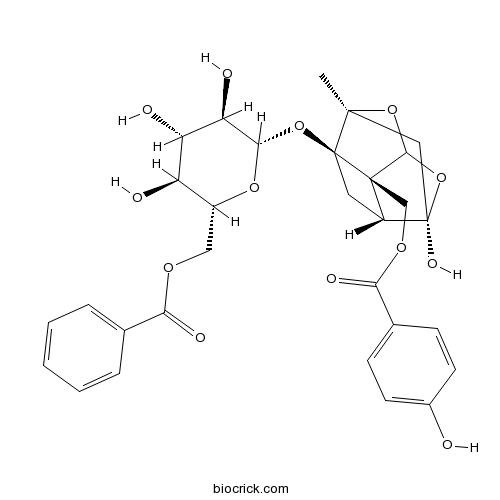BenzoyloxypeoniflorinCAS# 72896-40-3 |

Quality Control & MSDS
3D structure
Package In Stock
Number of papers citing our products

| Cas No. | 72896-40-3 | SDF | Download SDF |
| PubChem ID | 102004859 | Appearance | Powder |
| Formula | C30H32O13 | M.Wt | 600.57 |
| Type of Compound | Monoterpenoids | Storage | Desiccate at -20°C |
| Solubility | Soluble in Chloroform,Dichloromethane,Ethyl Acetate,DMSO,Acetone,etc. | ||
| SMILES | CC12CC3(C4CC1(C4(C(O2)O3)COC(=O)C5=CC=C(C=C5)O)OC6C(C(C(C(O6)COC(=O)C7=CC=CC=C7)O)O)O)O | ||
| Standard InChIKey | VIWQCBZFJFSCLC-IPRVBXPUSA-N | ||
| General tips | For obtaining a higher solubility , please warm the tube at 37 ℃ and shake it in the ultrasonic bath for a while.Stock solution can be stored below -20℃ for several months. We recommend that you prepare and use the solution on the same day. However, if the test schedule requires, the stock solutions can be prepared in advance, and the stock solution must be sealed and stored below -20℃. In general, the stock solution can be kept for several months. Before use, we recommend that you leave the vial at room temperature for at least an hour before opening it. |
||
| About Packaging | 1. The packaging of the product may be reversed during transportation, cause the high purity compounds to adhere to the neck or cap of the vial.Take the vail out of its packaging and shake gently until the compounds fall to the bottom of the vial. 2. For liquid products, please centrifuge at 500xg to gather the liquid to the bottom of the vial. 3. Try to avoid loss or contamination during the experiment. |
||
| Shipping Condition | Packaging according to customer requirements(5mg, 10mg, 20mg and more). Ship via FedEx, DHL, UPS, EMS or other couriers with RT, or blue ice upon request. | ||
| Description | 1. Benzoyloxypeoniflorin contributes to improving blood circulation through their inhibitory effects on both platelet aggregation and blood coagulation. |
| Targets | PAFR |

Benzoyloxypeoniflorin Dilution Calculator

Benzoyloxypeoniflorin Molarity Calculator
| 1 mg | 5 mg | 10 mg | 20 mg | 25 mg | |
| 1 mM | 1.6651 mL | 8.3254 mL | 16.6508 mL | 33.3017 mL | 41.6271 mL |
| 5 mM | 0.333 mL | 1.6651 mL | 3.3302 mL | 6.6603 mL | 8.3254 mL |
| 10 mM | 0.1665 mL | 0.8325 mL | 1.6651 mL | 3.3302 mL | 4.1627 mL |
| 50 mM | 0.0333 mL | 0.1665 mL | 0.333 mL | 0.666 mL | 0.8325 mL |
| 100 mM | 0.0167 mL | 0.0833 mL | 0.1665 mL | 0.333 mL | 0.4163 mL |
| * Note: If you are in the process of experiment, it's necessary to make the dilution ratios of the samples. The dilution data above is only for reference. Normally, it's can get a better solubility within lower of Concentrations. | |||||

Calcutta University

University of Minnesota

University of Maryland School of Medicine

University of Illinois at Chicago

The Ohio State University

University of Zurich

Harvard University

Colorado State University

Auburn University

Yale University

Worcester Polytechnic Institute

Washington State University

Stanford University

University of Leipzig

Universidade da Beira Interior

The Institute of Cancer Research

Heidelberg University

University of Amsterdam

University of Auckland

TsingHua University

The University of Michigan

Miami University

DRURY University

Jilin University

Fudan University

Wuhan University

Sun Yat-sen University

Universite de Paris

Deemed University

Auckland University

The University of Tokyo

Korea University
- CHIR-090
Catalog No.:BCC1477
CAS No.:728865-23-4
- Agatharesinol
Catalog No.:BCN4594
CAS No.:7288-11-1
- Crocandine
Catalog No.:BCN2070
CAS No.:72855-83-5
- Echitoveniline
Catalog No.:BCN7490
CAS No.:72855-79-9
- 1-Benzyl-5-phenylbarbituric acid
Catalog No.:BCC8461
CAS No.:72846-00-5
- MIRA-1
Catalog No.:BCC2409
CAS No.:72835-26-8
- Deoxyartemisinin
Catalog No.:BCN4285
CAS No.:72826-63-2
- Atanine
Catalog No.:BCN3317
CAS No.:7282-19-1
- OSI-930
Catalog No.:BCC1253
CAS No.:728033-96-3
- Panaxydol
Catalog No.:BCN3701
CAS No.:72800-72-7
- Estropipate
Catalog No.:BCC7719
CAS No.:7280-37-7
- Linderalactone
Catalog No.:BCN1251
CAS No.:728-61-0
- 4-Propenylbrenzcatechin
Catalog No.:BCN3672
CAS No.:72898-29-4
- Isocrocandine
Catalog No.:BCN2071
CAS No.:72903-70-9
- O-Methylcedrelopsin
Catalog No.:BCN3637
CAS No.:72916-61-1
- (Z)-Butylidenephthalide
Catalog No.:BCN4007
CAS No.:72917-31-8
- α,β-Methyleneadenosine 5'-triphosphate trisodium salt
Catalog No.:BCC3591
CAS No.:7292-42-4
- (RS)-4-Carboxyphenylglycine
Catalog No.:BCC6601
CAS No.:7292-81-1
- Bohemamine
Catalog No.:BCN1958
CAS No.:72926-12-6
- K858
Catalog No.:BCC7760
CAS No.:72926-24-0
- Octadecyl p-coumarate
Catalog No.:BCN7235
CAS No.:72943-88-5
- 30-Hydroxylup-20(29)-en-3-one
Catalog No.:BCN4286
CAS No.:72944-06-0
- DL-Catechin
Catalog No.:BCN6325
CAS No.:7295-85-4
- Carvedilol
Catalog No.:BCC4324
CAS No.:72956-09-3
Platelet anti-aggregatory and blood anti-coagulant effects of compounds isolated from Paeonia lactiflora and Paeonia suffruticosa.[Pubmed:20824965]
Pharmazie. 2010 Aug;65(8):624-8.
The roots of two Paeoniaceae family members have long been used as traditional medicines in Korea, China, and Japan. Dry roots of Paeonia lactiflora and dry root bark of P. suffruticosa are used under the traditional names of Paeoniae Radix and Moutan Cortex, respectively. Both Paeoniae Radix and Moutan Cortex have been used as remedies for cardiovascular diseases, for improving blood circulation, or for other uses. It was postulated that both plants may contain common active constituents that contribute to inhibiting blood coagulation and/or platelet aggregation. Eighteen compounds, which have been reported to be present in both plant medicines, were evaluated for their effects on platelet aggregation and blood coagulation. Paeonol (5), paeoniflorin (9), benzoylpaeoniflorin (11), and benzoyloxypaeoniflorin (12) were found to be the major common active constituents and they would collectively contribute to improving blood circulation through their inhibitory effects on both platelet aggregation and blood coagulation. In addition, methylgallate (4), (+)-catechin (7), paeoniflorigenone (8), galloylpaeoniflorin (13), and daucosterol (16) may also take part in improving blood circulation by inhibiting ether platelet aggregation and/or blood coagulation.


